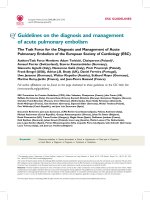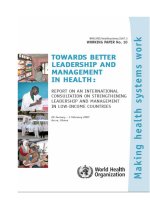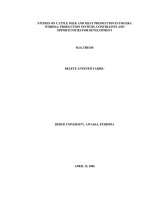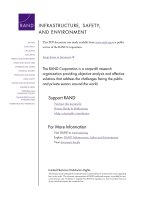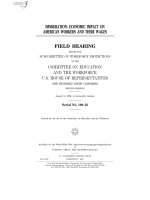Investigations on keloid pathogenesis and therapy
Bạn đang xem bản rút gọn của tài liệu. Xem và tải ngay bản đầy đủ của tài liệu tại đây (4 MB, 168 trang )
i
INVESTIGATIONS ON KELOID
PATHOGENESIS AND THERAPY
Anandaroop Mukhopadhyay
(B.Pharm), The Tamilnadu Dr M.G.R Medical University, INDIA)
THESIS SUBMITTED
FOR THE DEGREE OF DOCTOR OF PHILOSOPHY
DEPARTMENT OF PHARMACY
NATIONAL UNIVERSITY OF SINGAPORE
2007
ii
ACKNOWLEDGEMENT
It is my pleasure to thank the many people who made this thesis possible.
To start with, I would like to thank my Ph.D. supervisor Associate Professor Chan Sui
Yung for her excellent guidance and support. Had it not been for her, I wouldn’t have had
the courage to explore new horizons. Her critical evaluation of my research and constant
encouragement invigorated me to push the limits.
It is difficult to overstate my gratitude to my co-supervisor Assistant Professor Phan Toan
Thang. He took me in his research team knowing fully well that I had no experience in
skin biology. I thank him for having confidence in me and providing me the opportunity
to be a part of the cutting edge research in skin pathogenesis in his laboratory. With his
enthusiasm, his inspiration, and his great efforts to explain things clearly and simply, he
helped to make research fun for me. Throughout the period of writing my thesis, he
provided encouragement, sound advice, good teaching, good company, and lots of good
ideas. I would have been lost without him.
I am deeply indebted and thankful to my parents Subhash Chandra Mukhopadhyay and
Gopa Mukhopadhyay for instilling in me, values, that helped me comprehend the
importance of knowledge and pursue it. My brothers Abhiroop Mukhopadhyay and
Ritobrata Banerjee have always been my mentors and I am thankful to them for their
invaluable advice. I would also like to thank my uncle Dr M.G Banerjee for always
believing in me, and the rest of my family members for their support. Finally I am
grateful to all my friends and lab mates for making my graduate life enjoyable.
iii
TABLE OF CONTENTS
Acknowledgement
List of Publications
List of Figures
Abbreviations
Summary
1 BACKGROUND AND INTRODUCTION 4
1.1 OVERVIEW OF THE WOUND HEALING PROCESS 5
1.2 KELOID SCAR 7
1.2.1 Clinical Characteristics of Keloid 7
1.2.2 Epidemiology 9
1.2.3 Histopathology 9
1.2.4 Molecular Pathogenesis 11
1.2.5 Current Treatment 16
1.3 OBJECTIVES OF THE PRESENT STUDY 19
2 MATERIALS AND METHODS 21
2.1 MEDIA AND CHEMICALS 22
2.2 RECOMBINANT GROWTH FACTORS AND ANTIBODIES 22
2.3 PREPARATION OF NORMAL AND KELOID TISSUE EXTRACTS 23
2.4 IMMUNOHISTOCHEMISTRY 24
2.4.1 Preparation of Paraffin Sections of Normal and Keloid Tissues 24
2.4.2 Pretreatment of Paraffin Sections for Immunohistochemistry 24
2.4.3 Probing with Antibody and Developing 25
2.5 CELL CULTURE 25
2.5.1 Keloid Keratinocyte and Fibroblast Database 25
2.5.2 Keloid and Normal Keratinocytes from Keloid scar and Normal Skin 26
2.5.3 Keloid and Normal Fibroblast from Keloid Scar and Normal Skin 26
2.5.4 Keratinocyte-fibroblast Coculture 27
2.6 CELL COUNTING 29
2.7 TREATMENT OF FIBROBLASTS WITH GROWTH FACTOR 29
2.8 TREATMENT OF CELLS WITH GLEEVEC 29
2.9 SERUM STIMULATION 30
2.10 MTT ASSAY 30
2.11 FIBROBLAST-POPULATED COLLAGEN LATTICE (FPCL) 31
2.11.1 Preparation of Fibroblast-Populated Collagen Lattices 31
2.11.2 Macroscopic Evaluation of FPCL Contraction 32
2.12 WESTERN BLOTTING 32
2.13 IMMUNOASSAY 33
iv
2.14 FLOW CYTOMETRY 33
2.15 RNASE PROTECTION ASSAY 34
2.16 RATE OF ATP SYNTHESIS 34
2.17 MEASUREMENT OF INTRACELLULAR ATP 35
2.18 STATISTICAL ANALYSIS 35
3 ROLE OF EPITHELIAL-MESENCHYMAL INTERACTIONS IN WOUND CONTRACTION
AND SCAR CONTRACTURE 36
3.1 INTRODUCTION 37
3.2 RESULTS 39
3.3 DISCUSSION 46
4 ROLE OF ACTIVIN-FOLLISTATIN SYSTEM IN KELOID PATHOGENESIS 50
4.1 INTRODUCTION 51
4.2 RESULTS 53
4.3 DISCUSSION 67
5 ROLE OF PROTEOGLYCANS IN KELOID PATHOGENESIS 73
5.1 INTRODUCTION 74
5.2 RESULTS 77
5.3 DISCUSSION 94
6 ROLE OF STEM CELL FACTOR AND C-KIT SYSTEM IN KELOID PATHOGENESIS 101
6.1 INTRODUCTION 102
6.2 RESULTS 104
6.3 DISCUSSION 117
7 INVESTIGATION OF GLEEVEC AS A THERAPEUTIC AGENT FOR KELOID SCARS 124
7.1 INTRODUCTION 125
7.2 RESULTS 127
7.3 DISCUSSION 134
General Conclusion
Appendix 1
v
LIST OF PUBLICATIONS
Publication Papers
1. Mukhopadhyay A, Tan EK, Khoo YT, Chan SY, Lim IJ, Phan TT. Conditioned medium
from keloid keratinocyte/keloid fibroblast coculture induces contraction of fibroblast-
populated collagen lattices. Br J Dermatol 2005 Apr; 152(4):639-45.
2. Phan TT, Lim IJ, Aalami O, Lorget F, Khoo A, Tan EK, Mukhopadhyay A
, Longaker
MT Smad3 signaling plays an important role in keloid pathogenesis via epithelial-
mesenchymal interactions. J Pathol 2005 Oct; 207(2):232-42.
3. Khoo A, Ong CT, Tan EK, Mukhopadhyay A
, IJ Lim, TT Phan. The role of Connective
Tissue Growth Factor (CTGF) in the biology of epithelial-mesenchymal interactions of
keloid pathogenesis. J Cell Physiol 2006 Aug; 208(2):336-43
4. Mukhopadhyay A
, Chan SY, Lim IJ, Phillips DJ, Phan TT. The role of Activin System in
Keloid Pathogenesis. Am J Physiol-Cell Physiol 2006 Sep 13(in press)
5. Ong CT, Khoo A, Tan EK, Mukhopadhyay A
, Do DV, Han CH, IJ Lim, TT Phan.
Epithelial-mesenchymal interactions in keloid pathogenesis modulate vascular
endothelial growth factor expression and secretion. J Pathol 2007; 211:95-108
6. Do DV, Mukhopadhyay A
, Lim IJ, Phan TT. Roles of epithelial-mesenchymal
interactions in keloid scar pathogenesis and carcinogenesis. A review. Current Signal
Transduction Therapy (invited review paper, in press).
7. Mukhopadhyay A
, Fan S, Do DV, Khoo A, Ong CT, Lim IJ, Phan TT. Role of HGF /c-
Met system in keloid pathogenesis. Br J Dermatol, (in press).
vi
Submitted manuscripts
1. Mukhopadhyay A, Khoo A, Chan SY, Aalami O, Lim IJ, Phan TT. Specific Target of
Sp1 Transcription Factor: A Novel Therapeutic Approach for Keloids.
2. Mukhopadhyay A,
Wong MY, Chan SY
, Do DV
, Khoo A
, Ong CT
, Cheong HH
, Lim
IJ
, Phan TT. Syndecan-2 and Decorin - Proteoglycans with a difference: Implications in
keloid pathogenesis.
Presentations
1. NHG Annual Scientific Congress, Singapore, October 2004
2. AAPS (American Association of Pharmaceutical Scientists) Annual Meeting and
Exposition, Baltimore, USA, November 2004
3. 17th Pharmacy Congress and Intervarsity Symposium, Singapore, July 2005
4. 3rd Meeting of the WHSS (Wound Healing Society of Singapore), Singapore, August
2005
5. Inaugural AAPS-NUS Student Chapter Symposium, Singapore, September 2005
6. Controlled Release Society Conference, Vienna, Austria, July 2006
7. Biostar Congress, Stuttgart, Germany, October 2006
vii
LIST OF FIGURES
FIGURE 1: SCHEMATIC REPRESENTATION OF DIFFERENT STAGES OF WOUND REPAIR (ADAPTED FROM
WERNER ET AL., 2003) 6
FIGURE 2: KELOID FORMATION IN DIFFERENT PATIENTS (ADAPTED FROM MARNEROS ET AL., 2004) 8
FIGURE 3: H&E STAINING OF NORMAL SKIN AND KELOID SCAR TISSUE 10
FIGURE 4: SCHEMATIC REPRESENTATION OF PATHWAYS POTENTIALLY RESULTING IN ACCUMULATION OF
COLLAGEN IN FIBROTIC SKIN DISEASES
(ADAPTED FROM UITTO ET AL., 2007) 16
FIGURE 5: COCULTURE OF EPIDERMAL KERATINOCYTES AND DERMAL FIBROBLASTS AS AN IN VITRO MODEL
TO STUDY EPITHELIAL-MESENCHYMAL INTERACTION ERROR! BOOKMARK NOT DEFINED.
FIGURE 6: EFFECT OF CONDITIONED MEDIA COLLECTED FROM KELOID KERATINOCYTE (KK)/KELOID
FIBROBLAST (KF) CO CULTURES ON COLLAGEN CONTRACTION BY KFS 42
FIGURE 7: COMPARISON OF CONTRACTION OF COLLAGEN GEL LATTICE INCORPORATED WITH KELOID
FIBROBLASTS
(KFS) AND NORMAL FIBROBLASTS (NFS). 43
FIGURE 8: Α-SMOOTH MUSCLE ACTIN (Α-SMA) EXPRESSION BY KELOID FIBROBLASTS (KFS) (A) OR NORMAL
DERMAL FIBROBLASTS (NFS) (B) 44
FIGURE 9: EFFECT OF ANTI TRANSFORMING GROWTH FACTOR (TGF)-Β1 NEUTRALIZING ANTIBODY ON
COLLAGEN CONTRACTION BY KELOID FIBROBLAST
(KF) STRAIN 48 (KF48) INDUCED BY CONDITIONED
MEDIA COLLECTED FROM KELOID KERATINOCYTE
(KK) STRAIN 48 (KK48)/KF48 COCULTURE. 45
FIGURE 10: INCREASED LOCALIZATION OF ACTIVIN-A AND FOLLISTATIN IN THE BASAL LAYER OF EPIDERMIS
IN NORMAL AND KELOID TISSUES
57
FIGURE 11: EXPRESSION OF ENDOGENOUS ACTIVIN-ΒA MRNA DERIVED FROM NORMAL AND KELOID TISSUES.
58
FIGURE 12: ELEVATED LEVELS OF ACTIVIN-A OBTAINED FROM KELOID FIBROBLAST CULTURES 59
FIGURE 13: INCREASED PROLIFERATION OF NORMAL FIBROBLASTS WHEN COCULTURED WITH ACTIVIN-A
OVEREXPRESSING HΒ
AHACAT CELLS. 60
viii
FIGURE 14: INCREASED PROLIFERATION OF NORMAL AND KELOID FIBROBLASTS TREATED WITH RHACTIVIN-
A. 61
FIGURE 15: EFFECT OF ACTIVIN-A, FOLLISTATIN OR TGF-Β1 ON COLLAGEN, FIBRONECTIN AND Α-SMA
EXPRESSION
63
FIGURE 16: ACTIVIN-A EXPRESSION INCREASED BY EPITHELIAL-MESENCHYMAL INTERACTIONS RESULTING
IN A FIBROTIC PHENOTYPE
. 72
FIGURE 17: ELEVATED LEVELS OF SYNDECAN-2 IN TISSUE EXTRACTS OBTAINED FROM KELOID TISSUE. 81
FIGURE 18: SERUM GROWTH FACTORS UPREGULATED SYNDECAN-2 EXPRESSION IN NORMAL AND KELOID
FIBROBLASTS. 82
FIGURE 19: INCREASED ECTODOMAIN SHEDDING OF SYNDECAN-2 IS OBSERVED IN KELOID COCULTURES AS
COMPARED TO MONOCULTURES 83
FIGURE 20: EXOGENOUS RHFGF-2 STIMULATES SHEDDING OF SYNDECAN-2 FROM FIBROBLAST CELL
SURFACE INTO THE CONDITIONED MEDIA
84
FIGURE 21: INCREASED LOCALIZATION OF FGF-2 IN THE BASAL LAYER OF EPIDERMIS AND DERMIS IN KELOID
TISSUE. 85
FIGURE 22: ELEVATED LEVELS OF FGF-2 IN TISSUE EXTRACTS OBTAINED FROM KELOID TISSUE. 86
FIGURE 23: COCULTURED NORMAL AND KELOID KERATINOCYTES EXPRESS INCREASED LEVELS OF FGF-2 AS
COMPARED TO MONOCULTURED KERATINOCYTES. 87
FIGURE 24: COCULTURED NORMAL AND KELOID FIBROBLASTS EXPRESS INCREASED LEVELS OF FGF-2 AS
COMPARED TO CELLS IN MONOCULTURE
88
FIGURE 25: DOWNREGULATION OF DECORIN IN TISSUE EXTRACTS OBTAINED FROM KELOID TISSUE 89
FIGURE 26: SERUM GROWTH FACTORS DOWNREGULATE DECORIN EXPRESSION IN NORMAL AND KELOID
FIBROBLASTS
. 90
FIGURE 27: INCREASED SECRETORY DECORIN IN COCULTURED NORMAL FIBROBLASTS AND NOT KELOID
FIBROBLASTS
. 91
FIGURE 28: EFFECT OF DECORIN ON COLLAGEN, FIBRONECTIN AND Α-SMA EXPRESSION 92
FIGURE 29: ECTODOMAIN SHEDDING OF SYNDECAN-2 BY FGF-2 STIMULATED BY EPITHELIAL-MESENCHYMAL
INTERACTIONS RESULTING IN A FIBROTIC PHENOTYPE 100
ix
FIGURE 30: ELEVATED LEVELS OF SCF IN TISSUE EXTRACTS OBTAINED FROM KELOID TISSUE 107
FIGURE 31: SERUM GROWTH FACTORS UPREGULATED SCF EXPRESSION IN NORMAL AND KELOID
FIBROBLASTS
. 108
FIGURE 32: INCREASED LEVELS OF SCF IN CONDITIONED MEDIA OBTAINED FROM KELOID COCULTURES AS
COMPARED TO MONOCULTURES
109
FIGURE 33: ELEVATED LEVELS OF C-KIT AND PHOSPHO C-KIT (TYR 703, TYR 721) IN TISSUE EXTRACTS
OBTAINED FROM KELOID TISSUE. 110
FIGURE 34: INCREASED LOCALIZATION OF C-KIT IN THE BASAL LAYER OF EPIDERMIS OF KELOID TISSUE 111
FIGURE 35: C-KIT UPREGULATED IN KELOID KERATINOCYTES AS COMPARED TO NORMAL KERATINOCYTES.
112
FIGURE 36: INCREASED ECTODOMAIN SHEDDING OF C-KIT IN KELOID KERATINOCYTE/KELOID FIBROBLAST
COCULTURES. 112
FIGURE 37: TACE OVEREXPRESSED IN KELOID SCAR AS COMPARED TO NORMAL SKIN 115
FIGURE 38: UPREGULATION OF TACE IN KELOID FIBROBLAST COCULTURES AS COMPARED TO NORMAL
COCULTURES. 116
FIGURE 39: C-KIT SYSTEM IN KELOID PATHOGENESIS 122
FIGURE 40: NO SIGNIFICANT DIFFERENCE IN THE PROLIFERATIVE POTENTIAL OF KELOID KERATINOCYTES
AND KELOID FIBROBLASTS 129
FIGURE 41: GLEEVEC DOWNREGULATES EXPRESSION OF PHOSPHO AKT, PHOSPHO MTOR, PHOSPHO C-KIT
(TYR 721). 130
FIGURE 42: GLEEVEC DOWNREGULATES EXPRESSION OF COLLAGEN, FIBRONECTIN, Α-SMA, VEGF, HDGF,
TGF-Β1, SCF, FGF-2 131
FIGURE 43: GLEEVEC SIGNIFICANTLY REDUCES THE CONTRACTION OF COLLAGEN GEL LATTICE
INCORPORATED WITH KELOID FIBROBLASTS
. 132
FIGURE 44: GLEEVEC SIGNIFICANTLY REDUCES THE INTRACELLULAR ATP AND THE RATE OF ATP SYNTHESIS
IN KELOID FIBROBLASTS
. 133
FIGURE 45: SUMMARY OF VARIOUS GROWTH FACTORS INVOLVED IN KELOID PATHOGENESIS AND THE
POSSIBLE THERAPEUTIC TARGETS 139
x
ABBREVIATIONS
ALK
Activin receptor – like kinase
BMP
Bone morphogenetic protein
CTGF
Connective tissue growth factor
DMEM
Dulbecco’s modified Eagle medium
ECM
Extracellular matrix
EGF
Epidermal growth factor
ELISA
Enzyme-Linked Immunosorbent Assay
ERK
Extraregulated Kinase
FCS
Fetal calf serum
FGF-2
Basic fibroblast growth factor
FPCL
Fibroblast populated collagen lattice
FPD
Fibroproliferative disorder
GADPH
glyceraldehyde-3-phosphate dehydrogenase
HBSS
Hank’s balanced salt solution
HDGF
Hepatocyte derived growth factor
HSPG
Heparan Sulfate Proteoglycan
IgG
Immunoglobulin G
IgM
Immunoglobulin M
xi
JNK
Jun-Amino terminal-Kinase
KF
Keloid fibroblasts
KGM
Keratinocyte growth medium
KK
Keloid keratinocytes
MAPK
Mitogen-Activated-Protein-Kinase
mTOR
Mammalian target of rapamycin
MTT
3-(4,5-dimethylthiazol-2-yl)-2,5-diphenyltetrazolium bromide
NF
Normal fibroblasts
NK
Normal keratinocytes
PBS
Phosphate buffered saline
SCF
Stem cell factor
TGF-β1
Transforming growth factor-beta1
VEGF
Vascular endothelial growth factor
α-SMA
Alpha-Smooth Muscle Actin
1
SUMMARY
Keloid scars are a result of such an aberration in wound healing, and are characterized by
overabundant collagen/ECM deposition. Several treatment modalities have been explored
but none of the treatments are effective. In spite of the large number of growth factors,
cytokines and chemokines, that have been studied and are now known to play a role in its
pathogenesis, the precise pathobiology leading to this scar formation remains largely
unknown. Thus to identify new targets for therapeutic intervention, it is imperative to
identify key modulators which are aberrantly expressed in keloids and to understand and
assess the role of these modulators towards this fibrotic phenotype.
This study aims to identify key modulators of cellular dynamics in keloid scars and
investigate the effect of epithelial-mesenchymal interactions on the expression profile of
these modulators using various in vitro models. This study further explores different
growth factors or chemical drugs as potential therapeutic agents for keloid scars.
Bearing in mind the importance of wound contraction and scar contracture in the wound
healing process and scar formation respectively, an in vitro coculture model and a
fibroblast-populated collagen lattice was employed to study the role of epithelial-
mesenchymal interaction towards a contractile phenotype. It was observed that
epithelial-mesenchymal interactions increased the contractile response of both normal
and Keloid fibroblasts in vitro. In addition KF’s were shown to have an elevated
contracile response to signals from the extracellular envirionment than normal
fibroblasts, due to the increased expression of α-SMA, a contractile protein.
2
Further studies were performed to investigate the molecular effectors of keloid scars and
the effect of epithelial-mesenchymal interaction on the expression profile of these
effectors.
Activin-A, a dimeric protein and a member of the TGF-β superfamily, has been shown to
regulate various aspects of cell growth and differentiation in the repair of the skin
mesenchyme and the epidermis. Thus the study aimed at investigating the role of activin
and its antagonist, follistatin, in keloid pathogenesis. The findings strongly suggest that
activin-A is a potent inducer of fibroblast activation and involved in the pathogenesis of
keloids. They also emphasize the importance of follistatin in regulating activin-A
bioactivity and suggest a possible therapeutic potential of follistatin in the treatment and
prevention of keloids.
Most of the growth factors and cytokines involved in the wound healing process seem to
be immobilized at the cell surface and extracellular matrix via binding with
proteoglycans, making them important modulators of cell dynamics. Thus the expression
of two proteoglycans, namely syndecan-2 and decorin, were investigated in order to
elucidate their roles in keloid pathogenesis.
It was demonstrated that syndecan-2 and FGF-2 were not only overexpressed in keloid
tissues but could also interact with each other resulting in the shedding of syndecan-2
which could in turn activate a whole cascade of events resulting in keloidogenesis. In
addition, decorin appeared to be downregulated in keloid tissues, and this protein with
strong antifibrotic effects could have the potential to be used as a therapeutic agent for
keloids.
3
Finally the ubiquity of SCF and its tyrosine kinase receptor c-KIT in different kinds of
cells and tissues, and their importance in wound healing and cancer led to their
investigation as potential players in keloid pathogenesis. The study demonstrated that
both SCF and c-KIT were upregulated in keloid scar tissues in vivo. They were also
upregulated in cultured fibroblasts on stimulation with serum highlighting their possible
role in the initial phases of the healing process when the wound is flooded with serum. In
addition, we demonstrated that epithelial-mesenchymal interactions, mimicked by
coculture of keratinocytes and fibroblasts in vitro, not only stimulated secretion of
soluble form of SCF in keloid cocultures but also brought about shedding of the
extracellular domain of c-KIT perhaps by upregulation of TACE which was also shown
to be elevated in keloid tissues and keloid cocultures. Although the increased
phosphorylation of c-KIT suggests the activation of SCF/c-KIT pathway in keloid
cocultures, the exact role of the shed c-KIT is yet to be understood.
Having identified a tyrosine kinase receptor system as a major player in keloid
pathogenesis, we investigated the role of an established tyrosine kinase inhibitor, gleevec,
as a possible therapeutic agent for keloid scars. It was observed that although gleevec did
not have a significant effect on the proliferative potential of KF and KK, it was as able to
downregulate the expression of ECM components as well as profibrotic factors in KF via
inhibition of the c-KIT mediated PI3 kinase signaling pathway. It was also able to render
the KF less bioenergetic by reducing the intracellular ATP levels and their rate of ATP
synthesis. Thus given its effects, it has a potential of being a therapeutic agent for keloids.
4
1 BACKGROUND AND INTRODUCTION
5
1.1 OVERVIEW OF THE WOUND HEALING PROCESS
The wound healing process is a highly orchestrated process comprising of overlapping
phases of inflammation, granulation tissue formation, angiogenesis and remodeling of the
wound matrix (Clark et al., 1996). After wounding, the healing cascade immediately
ensues with the release of various growth factors and cytokines from the serum of the
disrupted blood vessels and degranulating platelets. The disruption of the blood vessels
results in the formation of a fibrin clot which not only works as a barrier for invading
microorganisms but also as a mesh for the binding of inflammatory cells, fibroblasts and
growth factors (Tuan et al., 1998). Within a few hours of injury, inflammatory cells like
neutrophils followed by monocytes and lymphocytes infiltrate the tissue and phagocytose
the bacteria. In addition to their role in defence against microorganisms, inflammatory
cells also serve as a pool for several growth factors and other macromolecules which are
required to intiate the proliferative phase of the healing process. The proliferative phase
involves the migration and proliferation of the keratinocytes from the wound edge
followed by the proliferation of fibroblasts in the area neighbouring the wound. These
fibroblasts then migrate into the wound area over a provisional wound matrix, deposit
large amounts of ECM and subsequently transform into myofibroblasts with a contractile
phenotype (Werner et al., 2003). Myofibroblasts are a group of actin rich fibroblasts and
are known to play an important role in wound contraction. Proto-myofibroblasts
differentiate to myofibroblasts by the production of α-SMA in order to generate more
force for contracture (Tomasek et al., 2002; Roy et al., 2001). At the same time,
angiogenic factors are released which promote angiogenesis by stimulating endothelial
cell proliferation leading to capillary tube formation. The resulting wound connective
6
tissue is called granulation tissue with nerve sprouting occuring at the wound edge.
Finally,
a transition from granulation tissue to mature scar occurs,
characterized by
continued collagen synthesis and collagen
catabolism. This process requires a balance
between matrix biosynthesis and matrix degradation. A disruption in this balance either
due to excessive matrix deposition or decreased matrix degradation leads to keloid and
hypertrophic scars (Nedelec et al., 1996; Raghow et al., 1994).
Figure 1: Schematic representation of different stages of wound repair (Adapted from
Werner et al., 2003).
A: 12–24 h after injury the wounded area is filled with a blood clot. Neutrophils invade into the
clot. B: at days 3–7 after injury, neutrophils undergo apoptosis. Instead, macrophages are
abundant in the wound tissue at this stage of repair. Endothelial cells migrate into the clot; they
proliferate and form new blood vessels. Fibroblasts migrate into the wound tissue, where they
proliferate and deposit extracellular matrix to form a granulation tissue. Keratinocytes proliferate
at the wound edge and migrate down the injured dermis and above the provisional matrix. C: 1–2
wk after injury the wound is completely filled with granulation tissue. Fibroblasts have
transformed into myofibroblasts, leading to wound contraction and collagen deposition. The
wound is completely covered with a neoepidermis.
12–24 h
Day 3-7
1-2 Week
7
1.2 KELOID SCAR
1.2.1 Clinical Characteristics of Keloid
Keloid scars represent a pathological response to cutaneous injury and occur only in
humans. The term ‘keloid’ is derived from a Greek word “khele” meaning crab claw
(Ladin et al., 1995). Keloids usually appear as firm broad nodules, often erythematous
and with a shiny surface (Marneros et al., 2004). A keloid scar extends beyond the
confines of the original wound, does not regress spontaneously, grows in pseudotumor
fashion with distortion of the lesion and tends to recur after excision. They are
notoriously resistant
to therapy. Numerous treatment modalities are available, none of
which are consistently effective (Poochareon et al., 2003).
Fibroproliferative disorders (FPD) involve various pathologic fibrotic conditions which
constitute a leading cause of mortality in the United States (from a 5 year running
average of the US bureau of vital statistics analysis of cause of death, 45% of deaths in
1988 included death due to any form of fibrosis of any organ or tissue) (Kozak et al.,
1988; Bitterman et al., 1991).
The keloid is a dermal form of FPD and although it has much less morbidity as compared
to FPD of other organs, it causes considerable functional and aesthetic problems
particularly after thermal injury (Tredget et al., 1990; Engrav et al., 1987). They have a
propensity to occur in melanocyte-rich regions like face, neck, deltoid, presternal area
and ear lobes (Kim et al., 2000; Crockett et al., 1964; Bayat et al., 2004). They have also
8
been reported to appear on the cornea (Shukla et al., 1975; Shoukrey et al., 1993; Lahav
et al., 1982).
Keloids are often compared with hypertrophic scars. Though their gross appearance is
similar, hypertrophic scars unlike keloid scars, remain confined to the borders of the
original wound and most of the times retain their shape (Mutalik et al., 2005) [21]. In
addition, though hypertrophic scars develop within a few weeks after skin injury, keloid
scars often show a delayed onset.
Figure 2: Keloid formation in different patients (Adapted from Marneros et al., 2004)
9
1.2.2 Epidemiology
There is believed to be a genetic and racial predisposition for the development of keloids
in darker-skinned races compared to lighter skinned people. Some 15-20% of blacks,
hispanics, and asians are afflicted with the disorder. Studies have reported incidence
ratios between the two groups to range from 2:1 to 19:1 (Oluwasnami et al., 1974; Omo-
Dare et al., 1975). Both autosomal dominant and autosomal recessive genetic inheritance
have been proposed but not confirmed (Omo-Dare et al., 1975). Although keloids are
known to occur sporadically, some data suggest familial occurrence (Bloom et al., 1956).
Differences in occurrence of keloids based on age and gender has also been reported. It
has been shown to be predominant in females and in populations between the ages of 10
and 30 (Cosman et al., 1961; Murray et al., 1981). Until now, no susceptibility genes for
keloid formation have been identified. TGF-β1, β2, β3, and TGF-β receptor
polymorphisms have bene studies but has not yielded any statistically significant
associations with keloids in case control studies (Bayat et al., 2002, 2003, 2004,2005 ).
The Difficulty in identifying genes specific to keloids among patients with keloids may
reflect genetic heterogeneity, whereby different genes contribute to keloid formation in
different families (Robies et al., 2007)
1.2.3 Histopathology
Contrary to the appearance of organized fibres in normal skin, keloids have stretched
collagen fibres aligned in the epidermal plane (Kelly et al., 1988). Excessive deposition
of collagen and other extracellular matrix components along with increased blood vessels
10
and cells are observed in the histological sections of keloids. However the microvessels
in keloids seem to be occluded perhaps to the increase proliferation of endothelial cells
(Kischer et al., 1992). Keloid scars are also characterized by presence of tongue-like
advancing edge underneath normal-appearing epidermis and papillary dermis (Lee et al.,
2004). Keloid sections are also characterized by a thickened epidermis and prominent
disarray of fibrous fascicles/nodules. Mast cells, macrophages, epidermal langerhan cells
have all been demonstrated to be elevated in keloids. However their role in keloid
pathogenesis is not well understood. At higher magnification using scanning electron
microscopy, the random nature of fiber orientation, varying fiber length and poor bundle
formation in keloids are observed.
Figure 3: H&E staining of normal skin and keloid scar tissues
Normal Skin Keloid Scar
11
1.2.4 Molecular Pathogenesis
The wound healing process involves a complex interplay of cells, mediators, growth
factors, and cytokines, leading to inflammation, cell proliferation, ECM deposition,
contraction and remodeling. Thus a disruption in the cellular harmony leads to either a
delayed healing response or execessive healing. The over healing response is marked by
an over exuberant deposition of collagen and other extracellular matrix components like
fibronectin by fibroblasts resulting in a scar which can either be keloidic or hypertophic.
Previous studies have demonstrated that keloid-derived fibroblasts produced 20 times
more type1 collagen than normal fibroblasts in vitro (Ladin et al., 1995; Ala-kokko et al.,
1987; Di cesare et al., 1990).
Keloids are characterized by an increased proliferation of fibroblasts in vitro (Calderon et
al., 1996). Recent studies have highlighted the importance of regulation of apoptosis, in
scar establishment and the development of a pathological scar.
Apoptosis-related genes
and proteins have been shown to be down-regulated or mutated in keloid tissues and
fibroblasts (Sayah et al., 1999; Chodon et al., 2000).
The bioactivity of fibroblasts in fibrogenesis or excessive scar formation is regulated by a
number of growth factors, of which the TGF-β family is thought to play a central role by
its regulation of fibroblast proliferation, differentiation and matrix production. It is
believed to enhance the production of ECM elements, such as fibronectin and collagen,
and to upregulate the cellular expression of matrix receptor integrin (Tuan et al., 1998;
Niessen et al., 1999; Kim et al., 2000).
12
TGF-β1 in particular has been widely implicated as a key modulator of cellular dynamics
in fibrosis. Many groups have demonstrated increased levels of TGF–β in keloid tissues
and other fibrotic disorders (Lee et al., 1999; Younai et al., 1994; Polo et al., 1999).
Peltonen
and co workers (1991) demonstrated that TGF-β1 mRNA and TGF-β1 protein
were associated
with excessive collagen synthesis and ECM accumulation
in keloids.
Shah’s group (1994) showed that blocking of TGF–β1 and TGF–β2 by the application of
antibodies to cutaneous wounds markedly reduced scarring. Liu and team (2002)
demonstrated, by an in vitro experiment, that the effects of TGF-β1 might be modulated
by an autocrine loop and that this autocrine regulation might play an essential role in
keloid formation and development. Further, Chodon’s group (2000)
reported that
dysregulation in the Fas-mediated apoptosis, which occurred in normal wound healing,
may be a factor contributing to scar formation and suggested a role for TGF-β1 in this
resistance.
Various other molecular pathways have been invoked in keloid pathogenesis. Platelet-
derived growth factor (PDGF) α-receptor expression was demonstrated to be elevated in
KF and this corresponded to an increase in mitotic response of the fibroblasts on
exposure to the PDGF isoforms (Haisa et al., 1994). An over expression of insulin-like
growth factor-I (IGF-1) receptor in KF was also demonstrated to enhance their invasive
potential highlighting the role of IGF-1 in keloid pathogenesis (Yoshimoto et al., 1999).
An elevated expression of interleukin (IL)-6 (Xue et al., 2000) and VEGF (Wu et al.,
2004; Le et al., 2004) has also been reported in KF.
13
As the wound milieu consists of various cell types, it would be foolhardy to implicate
fibroblasts alone as main players in fibrosis. Other cell types have also been shown to
play a role in keloid pathogenesis directly or indirectly by influencing the fibroblasts. An
elevated presence of mast cells was observed in keloids suggesting their possible role in
keloid pathogenesis (Russel et al., 1977). Upon further investigation it was observed that
an elevation of mast cell histamine resulted in an up-regulation of procollagen type 1
production in KF (Kikuchi et al., 1995; Tredget et al., 1998). Another cell type which has
been shown to play an important role in pathogenesis of scars is endothelial cells. Along
with fibroblasts they are known to be important in production of collagen (Milsom et al.,
1973; Sollberg et al., 1991; Diegelmann et al., 1977). It has been observed that
overproliferation of endothelial cells leads to occlusion of microvessel lumens in keloids
resulting in a severe hypoxic condition (Kischer et al., 1982). The resulting hypoxia
further stimulates endothelial cell proliferation and collagen production by fibroblasts by
releasing growth factors like HIF-1α and VEGF (Knighton et al., 1983; Kischer et al.,
1992; Zhang et al., 2006).
It is now becoming clear, that epithelial-mesenchymal interactions, initially applied to
normal skin homeostasis (Maas-Szabowski et al., 2000; Mackenzie et al., 1994; Fusenig
et al., 1994), are also instrumental in modulating fibroblast behaviour in keloids by
paracrine influences. Previous laboratory-based findings showed that keloid-derived
keratinocytes enhanced both normal and keloid-derived fibroblast proliferation and
collagen synthesis in a co-culture system (Lim et al., 2001; Funayama et al., 2003; Xia et
al., 2004). NF and KF cocultured with KK in defined serum-free media showed a higher
rate of proliferation compared to that of coculture with NK (Lim et al., 2001; Funayama
14
et al., 2003; Xia et al., 2004).
It was subsequently observed that KF co-cultured with KK
produced increased amounts of both collagens I and collagen III compared with coculture
with NK (Xia et al., 2004; Lim et al., 2002; Lim et al., 2003). Mitogen activation protein
kinase (MAPK) and phosphatidyl-inositol-3 kinase (PI-3K) pathway activation have been
observed in excessively proliferating KF cocultured with KK. When these fibroblasts
were treated with MAPK-p44/42 specific inhibitor and PI-3K specific inhibitor, it caused
complete nullification of collagen I and III production, and significantly decreased
fibronectin and laminin β2, all of which is produced in excess in keloidogenesis (Lim et
al., 2003). Electron microscopic analysis also demonstrated that the appearance of
collagen–extracellular matrix (ECM) produced by NF cocultured with KK in vitro,
approximated the morphological appearance of in vivo keloid scar tissue (Lim et al.,
2002).
Epithelial-mesenchymal interactions have been demonstrated to influence the
expression of various transcription factors, growth factors and cytokines in vitro. Phan
and his group (2005) demonstrated that epidermal-dermal interactions in keloids resulted
in activation of the TGFβ-Smad axis which in turn played a crucial profibrotic role in
keloid pathogenesis. Lim and his co-workers (2006) further demonstrated the modulation
of yet another transcription factor STAT-3 by epithelial-mesenhcymal interactions in
keloidic cells. Ong’s team (2007) used a two chambered coculture system to mimic
epithelial-mesenchymal interaction and reported the expression and secretion of VEGF to
be upregulated in KF on being coculutred with KK. Biologically active CTGF was also
shown to be secreted by KF only in the presence of overlying keratinocytes (Khoo et al.,
2006).




